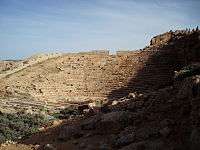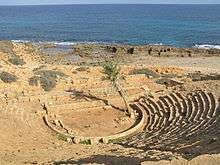Apollonia (Cyrenaica)
Apollonia (Greek: Ἀπολλωνία) in Cyrenaica (modern Libya) was founded by Greek colonists and became a significant commercial centre in the southern Mediterranean. It served as the harbour of Cyrene, 20 km (12 mi) to the southwest.
 Shown within Libya | |
| Location | Libya |
|---|---|
| Region | Jabal al Akhdar |
| Coordinates | 32.9°N 21.966667°E |
.png)

Apollonia became autonomous from Cyrene at latest by the time the area came within the power of Rome, when it was one of the five cities of the Libyan Pentapolis, growing in power until, in the 6th century A.D., it became the capital of the Roman province of Libya Superior or Libya Pentapolitana. The city became known as Sozusa, which explains the modern name of Marsa Susa[1] or Susa, which grew up long after the cessation of urban life in the ancient city after the Arab invasion of AD 643.[2]
Sozusa was an episcopal see and is included in the Catholic Church's list of titular sees.[3]
Ruins
The early foundation levels of the city of Apollonia are below sea level due to submergence in earthquakes, while the upper strata of the later Byzantine Christian periods are several meters above sea level, built on the accumulated deposits of previous periods. The existence of buildings in the sea was noted by Beechey (1827), with some rough drawings, and Goodchild (1950s) and André Laronde also published archaeological surveys of the site.[4] In 1958 and 1959 Nicholas Flemming, then an undergraduate at Cambridge University, led teams of undergraduates trained in scuba diving and underwater surveying to map the large sector of the city beneath the sea. The results of this work were published, complete with maps and diagrams of underwater buildings in the references cited below. Carlo Beltrame and colleagues have recently made an underwater photographic survey of some of the buildings.
The Crete earthquake and tsunami of 21 July 365 AD apparently caused extensive damage to the city and harbor.
The Apollonia (Susa) Museum houses many artifacts found on the ancient site.
The ancient port
The remains of the ancient port in Apollonia are extremely well preserved because they are underwater. The difference in sea level, indeed, was estimated to be around 3.70-3.80 m.[5] The port is relatively early in date, dating the 6th/7th Century BC, and this makes it unique as no other complete port is this old.[6]
Churches
Apollonia is particularly known for its ruins of three churches (out of five originally standing) dating from the Byzantine period. They are located at the south, center and east of the governor's palace. The eastern one, dating the 5th century, was the most important. The marble columns used is the nave are were reused as Spolia and come originally from Euboea.[7]
Palace
The Palace of the Dux was excavated by Goodchild between 1959 and 1962.[8] It was last used as the Byzantine Duke's Palace and contains over 100 rooms. A marble inscription testifyies its use as a Roman military commander's house, however the identification of the name and status of the man who edified the palace is problematic.[9]
Theatre
The well-preserved Greek theatre stands facing the sea outside the old city walls. This monument dates the 3rd century BCE and is therefore one of the oldest sites in Apollonia. The structure was modified under Domitian, suggesting its use as an arena for gladiatorial fights.[10] The 5th century saw the abandonment of the theatre and the re-use of the columns from the stage as spolia in the eastern basilica.The cavea has 28 seat levels.

Christian bishopric
Apollonia was also the seat of an ancient Christian bishopric of the Roman province of Libya Pentapolitana (Cirenaica). Before the advent of the emperor Diocletian, the city called Apollonia: with Diocletian became the capital of Libya Superior.[11][12] [13] Today Sozusa of Libya survives as a bishopric holder; The seat is vacant from 11 December 1989. Known bishops include:
- Eliodorus (fl.359)
- Zosimo (mentioned in 449)
- Hailé Mariam Cahsai (1951–1961)
- Duraisamy Simon Lourdusamy (1962–1964) of Bangalore
- Guido Attilio Previtali (1969–1989)
Present
Recently, vandals have smeared graffiti on columns.[14] Artifacts has also been looted.[15] Various treasures e.g. heads or entire torsos of statues listed in guidebooks issued in 2011 are stolen.[16] According to the head of the antiquities department of a parallel administration in charge of eastern Libya, “Many Artifacts have been smuggled abroad”.[14]
There was better site protection before 2011.[14]“There has been a lot of destruction in recent years,” said Ismail Miftah, a farmer living next to Cyrene.[14] Apollonia is featured as the chief port city for Cyrene in the 2017 video game Assassin's Creed Origins.
Apollonia is the main site of the graphic novel ALIX - LE DIEU SAUVAGE by Jacques Martin, published originally in 1969 in Tintin magazine in Belgium.
References
- Hogarth, David George (1911). . In Chisholm, Hugh (ed.). Encyclopædia Britannica. 7 (11th ed.). Cambridge University Press. pp. 704–705.
- D. White, "Apollonia (Marsa Susa) Libya" in The Princeton Encyclopedia of Classical Sites (Princeton University Press, 1976)
- Annuario Pontificio 2013 (Libreria Editrice Vaticana, 2013, ISBN 978-88-209-9070-1), p. 975
- (in French) André Laronde, Apollonia de Cyrénaïque : Archéologie et Histoire, Journal des savants, no 1, 1996, p. 3-49
- Baika, K., 2013, "Apollonia" in "Shipsheds of the Ancient Mediterranean"
- http://www.ancientportsantiques.com
- The Eerdmans Encyclopedia of Early Christian Art and Archaeology, Volume 1, Finney
- The palace of the Dux,Ellis,1985
- The Eerdmans Encyclopedia of Early Christian Art and Archaeology, Volume 1,Finney
- livius.org
- Apollonia at www.gcatholic.org
- Pius Bonifacius Gams, Series episcoporum Ecclesiae Catholicae, (Leipzig, 1931), p. 462.
- Michel Le Quien, Oriens christianus in quatuor Patriarchatus digestus, (Paris, 1740), vol.II, coll. 617–618.
- Reuters (2019-02-21). "Libya's ancient ruins blighted by theft, shunned by tourists". DAWN.COM. Retrieved 2019-02-23.
- "Libya's ancient ruins blighted by theft and destruction, shunned by tourists - Global Times". www.globaltimes.cn. Retrieved 2019-02-23.
- "Libya's ancient ruins blighted by theft, shunned by tourists". Reuters. 2019-02-20. Retrieved 2019-02-23.
- LookLex
- Beechey, F.W. 1827. Proceedings of an Expedition to Explore the North African coast. John Murray, London.
- Flemming, N.C. 1959. "Underwater adventure in Apollonia". Geographical Magazine, v. 31, pp. 497–508.
- Flemming, N.C. 1971. Cities in the Sea. Doubleday, New York, 222 pp; New English Library, London, 222pp.
- Flemming, N.C. and Webb, C.O, 1986. "Tectonic and eustatic coastal changes during the last 10,000 years derived from archaeological data". Zeitschrift für Geomorphologie. December, Suppl – Bd62, p. 1 29.
- The ancient port of Apollonia is an archaeological treasure to be preserved.
| Wikimedia Commons has media related to Apollonia, Libya. |
